Professor Leonard Barkan Embarks on a Personal Odyssey in Berlin for Jews

The book: Leonard Barkan’s Berlin for Jews: A Twenty-First-Century Companion (University of Chicago Press) is an idiosyncratic look at the bustling German metropolis through the lens of global and personal history. Barkan explores what it meant to be a Jew in Berlin in the 19th century, exploring the group’s prominence in the arts, sciences, and public life. Throughout Barkan’s travels, he ponders his own identity as a secular Jew, falling in love with the city not necessarily in spite of his Jewishness, but because of it. Berlin for Jews offers a solution to a long-vexing conundrum of how to engage with the German history and the unmistakable influence of Jewish culture on it while acknowledging the sobering legacy of World War II.
The author: Leonard Barkan is the Class of 1943 University Professor at Princeton where he teaches in the department of Comparative Literature and holds appointments in art and archeology, English, and classics. His books include The Gods Made Flesh; Metamorphosis and the Pursuit of Paganism (Yale University Press) and Unearthing the Past: Archeology and Aesthetics in the Making of Renaissance Culture (Yale University Press).
Opening lines: “For those who seek the body and soul of Jewish Berlin, whether on foot or in guidebooks, ground zero tends to be pinpointed in the Scheunenviertel, or ‘Barn Quarter,’ named for a proliferation of structures that once kept highly flammable hay, as well as some less than desirable inhabitants, away from center city. It’s a neighborhood within the larger outlines of Mitte that stretches away from such a community-defining status. Within this square mile we find some of the earliest authorized settlements of Jews in the metropolis; and, not far into this period of history, we can locate the entrance point into the Berlin of the fourteen-year-old beggar-student Moses Mendelssohn. Through the nineteenth century, it was the immigrant zone par excellence for the Ostjunden, immigrants from the East, after Berlin’s middle- and upper-class Jews had succeeded in leaving such oriental traces behind them. And — presumably uniting the opposite ends of the social spectrum — it became the site for the Neue Sinagoge when that grandiose building was constructed on Oranienburger Straße in the 1860s.”
Reviews: Simon Goldhill, author of Freud’s Couch, Scott’s Buttocks, Brontë’s Grave says: “What a delight this book is! Unlike all those companions and all those travel guides, here is a real companion with whom you want to journey: witty, conflicted, amused, amusing, insightful, smart. This book provides a wonderful sense of how place and stories go together — all touched with an elegant melancholy for a lost world and our part in making its memory still sing.”












No responses yet